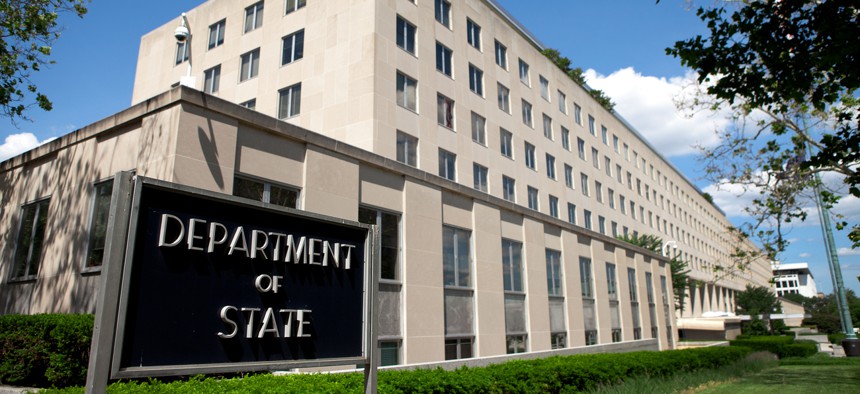
Mark Van Scyoc/Shutterstock.com
State Has Been Consistently Late Submitting Foreign Assistance Budget Documents, Watchdog Finds
In 2018, delays were partially due to staff shortages following the hiring freeze.
The State Department routinely fails to submit to Congress on time key budget documents on foreign assistance, the department’s watchdog reported. Staffing shortages following the federal hiring freeze imposed by former Secretary of State Rex Tillerson contributed to the delays in 2018, but State’s complex review process and weaknesses in data collection have also been factors since 2015.
The budget report “plays a critical role in the obligation of tens of billions of dollars in foreign assistance funds appropriated annually,” the Government Accountability Office reported on Monday. GAO noted that while the submission of the report does not legally affect State’s ability to obligate foreign assistance funds, consultations, spend plans, and congressional notifications cannot be completed until allocation amounts are finalized through the reporting process.
The Foreign Assistance Act requires the president to report to Congress the funding allocations by country and category of assistance within 30 days of Congress appropriating certain funds. State and the U.S. Agency for International Development decide funding allocations based on the administration's goals, Congress’s instructions and countries’ assistance needs. In 2018, the State Department was 159 days late in submitting reports on foreign assistance funds. This was the second longest delay during the 2015-2018 span GAO reviewed—the longest being 230 days in 2015.
State officials told GAO that staff shortages in 2018—which resulted from the departmentwide hiring freeze (which also affected USAID) that lasted from January 2017 to May 2018—were a significant problem in compiling the report that year. “Most of the delays in the fiscal year 2018 process occurred during the allocation negotiation, review, and agreement phase—which relies heavily on officials from the offices experiencing staffing gaps,” GAO reported.
In 2018, the department offices primarily responsible for the report had 15 of 54 vacant positions—nearly 30% of the staff. Also, 10 of the 30 USAID funded positions within those offices (33%) were vacant. Despite permission to fill the vacancies now, State and USAID officials do not have an action plan. “A lack of staff resources will likely continue to impact the timeliness” of these future reports,” the watchdog said.
Lengthy negotiations between State and USAID on how to make some appropriations also contributed to the delay in 2018. It was the first time Secretary of State Mike Pompeo and USAID Administrator Mark Green had gone through the process, and it took the Office of Management and Budget time to resolve policy issues relating to President Trump’s priorities. Although the report didn’t cite specific priorities, the Trump administration has been working since the inauguration to cut foreign aid.
Across the entire time span of review, State’s “complex process to address appropriation requirements and directives while also reflecting administration priorities,” led to delays, GAO said. The number of requirements and directives for the appropriations by Congress vary each year. From 2015 to 2018, they ranged from 546 to 1,056.
The process to address these requirements, such as rules on allocating funds for programs or requirement to submit a joint explanatory statement, involves coordination between USAID, OMB and about 200 bureaus and overseas posts. GAO said the process “is not designed to meet the mandated 30-day time frame” due to its complexity. When the reporting mandate began in 1971, Congress appropriated $2.2 billion in foreign assistance and the relevant portion of the bill was 18 pages. In contrast, Congress appropriated $33.7 billion for foreign aid in 2018, in legislation that ran to 138 pages.
Additionally, discrepancies in the spreadsheet of allocations led to delays because the spreadsheet is sent to the 200 bureaus and outposts to review and there isn’t a way to prevent them from making changes to the original. This made it difficult to “process all of the suggested changes and identify how the changes interact with the various requirements and directives” GAO said.
GAO noted that in 2016, Congress changed reporting requirements “to forestall the months-long negotiation process with the appropriations committees that had occurred in prior years,” which allowed the department to submit the report more timely in 2016. However delays have persisted since then.
Acting Director for GAO’s International Affairs and Trade Office Jason Bair said, “This is the first time we’ve looked in depth at this part of the State Department’s budget implementation process.” From December 2018 to September 2019, GAO analyzed guidance documents and reports related to foreign assistance, interviewed officials from State, USAID and the Office of Management and Budget and reviewed the relevant appropriations acts from 2015 to 2018.
GAO recommended that State identify ways to stream the review process, enhance data information systems to ensure better collection and create a plan to address vacancies in consultation with the USAID administrator when appropriate.
State concurred with all three recommendations. USAID concurred with the first two, but does not believe staff shortages at State contributed to delays. GAO responded by stating, “While we do not report that staffing gaps were the primary reason for State not meeting reporting deadlines, we did find them to be a contributing factor to the delays in fiscal year 2018.”







